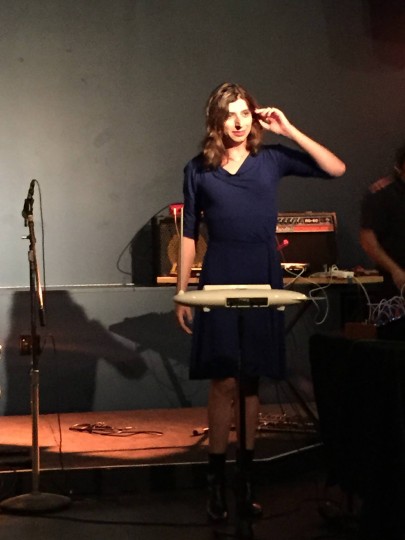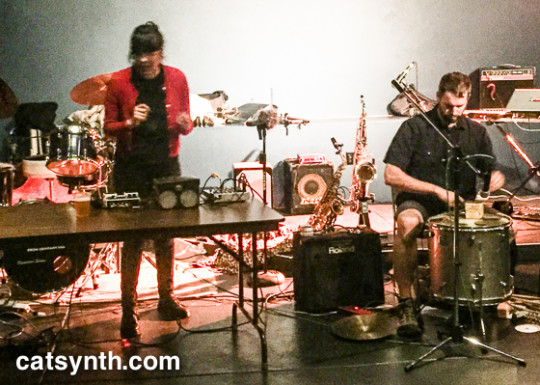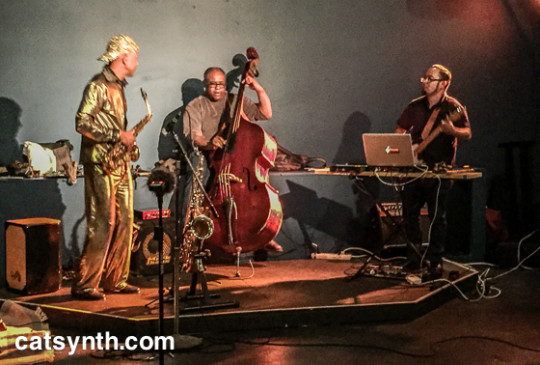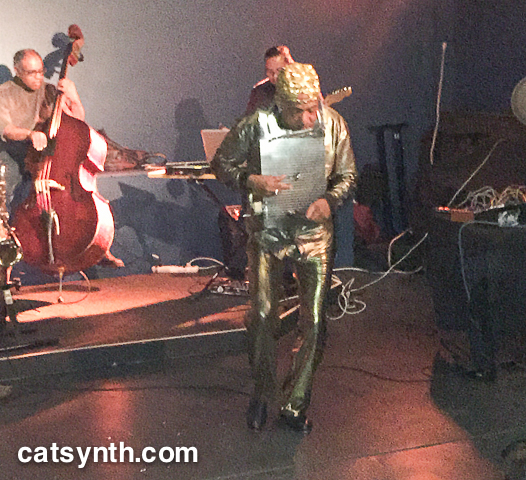By mdaane1 on YouTube, via matrixsynth.
This is too cute. And of course we love black cats and theremins 🙂

By mdaane1 on YouTube, via matrixsynth.
This is too cute. And of course we love black cats and theremins 🙂
Today we look back at the recent Analog Ladies edition of the Church of the Superserge that took place in late June at Robotspeak in San Francisco.
The Analog Ladies show featured solo performances by five women on analog synthesizers (along with some additional items). It was a diverse cross-section of musical and performance styles, with each artist being different focus to her set. First up was series regular Elise Gargalikis performing on a Serge Modular synthesizer with along with vocal samples and loops.

Gargalikis, who often performs as part of the duo, Slope114, has a mellifluous voice that rises above some of the noise sounds from the modular synth, while blending as a high note in longer drones.
Next up was Miss Moist, an Oakland-based electronic musician who describes her music as “electro candy pop // tropical kitsch”. She combined analog electronics with a Korg Electribe and Mini-Kaoss Pad.

[Photo by Tom Djll.]
The result was a blend of rhythms and sweet tones that did indeed match the description, but also moments of harsh glitching and moderate noise hits before returning back to the main patterns.
The next set featured Jill Fraser performing on her vintage Serge modular synthesizer.

Jill Fraser’s set featured fully formed compositions ranging over different parts of her career all the way to very recent. Some were very abstract, but with intricately detailed sound design on the Serge. I’ve always been impressed with the woodwind-like sounds that some musicians have been able to get from this instrument. There were also some melodic and rhythmic pieces as well, reflective of her career in film and TV.
Next up was Mint Park, who performed with an analog modular synthesizer made composed primarily of TipTop Audio modules along with a laptop running Ableton Live!

Her performance was intense. A strong set of beats with punctuated breaks was feed through the modular with hard grating noise that worked well in context. She kept up the energy for the entire duration of the set.
Then it was time to take the stage as the final act of show.

[Photo by Dmitri SFC]
For this set, I brought the full analog modular system, including some recent acquisitions such as the Hexinverter.net Mutant-Hijats – I opened the set with the Hihats controlled by the Make Noise Rene and the Moog Theremini. The Theremini, used exclusively as a CV controller for the modular synth, was the centerpiece of the set as it enabled full embodied performance. I also brought along the Garrahand drum, which works well fed into the Make Noise Echophon.

You can here my full performance in this video.
Amanda Chaudhary at Analog Ladies, Robotspeak, San Francisco from CatSynth on Vimeo.
I always try to make sure there is a variety of textures and energy-levels and weave together a narrative structure even within improvisation. Overall, I was very pleased with this set and the response from the large crowd.

[Photo by Tom Djll.]
Indeed, all the artists were well received by the overflowing crowd at Robotspeak – it’s not a large place, but it was filled with synth enthusiasts and those who enjoy more adventurous music. This was the first Analog Ladies edition of the Church of the Super Serge, but I certainly hope it won’t be the last.

[Photo courtesy of Robotspeak.]

We have covered several of the Church of the Superserge shows at Robotspeak over the past year or so. And now I will be performing in one as part of a special Analog Ladies edition. It will be an afternoon of analog synthesizer madness featuring several of instrument’s most talented women: Jill Fraser, Mint Park, Amanda Chaudhary, Miss Moist, and 7H1NG2. It’s a casual BYOB event, so if you’re in San Francisco (or anywhere on the Bay Area transit grid) and free tomorrow afternoon, please drop by Robotspeak (589 1/2 Haight Street in SF) to hear us.
I will performing on my analog modular plus Moog Theremini, and probably wearing something with a feline theme. Here is a photo of the modular as I start to set up the initial patch for tomorrow’s set.

Things will be a little less chaotic visually by show time tomorrow. Sonically, there might be some chaos, but that is completely intentional 🙂
As Pitta of the Mind prepares for our upcoming show next week, we look back at our last show in February at Outsound’s periodic Soundspeak series featuring experimental music and poetry groups.
For our set we performed several new pieces on the theme of film, with several poems evoking treatments and plots for possible (or impossible) films. The music featured a mixture of piano, Moog Theremini, modular synth and DSI Prophet 12, which made for quite an impressive setup.

As with most Pitta of the Mind shows, we had a color/pattern theme. On this evening the theme was white.



[Photos by Annabelle Port. Click to enlarge.]
The performance overall went quite well. You can here some audio excerpts below.
We were proceeded that evening by a trio featuring Nick Obando with Rob Pumpelly and Eli Wallace. The group performed several extended-length jazz pieces layered with Obando’s hip-hop-infused poetry.

I have to admit I do not recall much of the words/poetry, but the instrumental performance was quite memorable. I am a fan of Eli Wallace’s keyboard performance style, and Pumpelly and Obando brought their own strong technical skills to the mix. I particularly liked one piece that featured a funk rhythm with complex solos and patterns on top. The rhythm cut out in a few spots for freeform improvisation that was just long enough before returning to the funk pattern.
Overall, it was a good show, though a quiet night – possibly a combination of other performances happening that evening and the fact that the Luggage Store Gallery is at a temporary location while the main building is being renovated. But we certainly look forward to performing again, and hearing more music in the meantime.
Today we look back at a memorable show I played in a couple of weeks ago at Second Act here in San Francisco. Four acts each brought a different style of performance, instrumentation and experimentation to the stage.
First up was IMA, an electro-acoustic duo featuring Nava Dunkelman and Jeanie-Aprille Tang. Their sound blends the noisier edges of percussion with a range of electronic sources, including loops, samples, and percussive hits that complement the acoustic sources. It was a loud and intense affair, but with quiet sections. Dunkelman also used her voice during the performance as another instrument.
Then it was time to take the stage. This was another set featuring Moog Theremini and analog modular synthesizer. The color theme for this performance was blue.

[Photo by Tom Djll]
As with many of these electronic improvisation sets, it starts off very structured and then moves in different directions based on the audience, room, instrument behavior and inspiration. You can see the full performance in this video.
Amanda Chaudhary at Second Act from CatSynth on Vimeo.
Overall I was quite pleased with the performance and the audience reaction.
Next up was Voicehandler, a duo of Danishta Rivero and Jacob Felix Heule.

Their sound was a bit more subtle than the previous acts. It featured Rivero on extended vocal techniques with a water-based electro-acoustic instrument of her own invention, the Hydrophonium; and Heule on extended percussion techniques that were often subtle and precise before veering into more energetic territory.
The final act was a quartet led by Idris Ackamoor featuring Mark Heshima Williams on bass, Bob Marshall in drums, and David Molina on guitar and laptop with Ableton Live!

Several of the musicians and musical pieces were familiar from Ackamoor’s renowned “afro-futurist” group The Pyramids. Indeed, the performance followed a similar structure with both a rhythmic entry and recessional. The rhythm section of Williams and Marshall was solid and perfect for some of the funkier grooves; and Ackamoor managed to move effortlessly between roles as horn-player and solo tap-dancing. It was interesting to hear David Molina and his guitar+electronic work, which I have heard before as a solo project, blended into this context.

All together it was a good show from all four groups, a diverse range of music. The large audience seem drawn to all the acts even if they initially came following one. And it’s great to see spaces like Second Act continuing to host shows like this in San Francisco. I hope to play there again sometime soon.
By timbolature on YouTube, via matrixsynth.
“A Moog Theremini comes to visit, and finds a fan in the form of Tom the Cat. Recorded by Offspring #2.”
Tom is playing the Theremini in way that only a cat can play 🙂

Via matrixsynth. (PS: thanks for the shoutout for the app 🙂 ).
This one in via L.T.
“After my beloved orange four legged companion ‘Charlotte the Cat’ passed on and ascended high into SynthCat heaven, I have realized that Charlotte was always annoyed with my collection of electronic keyboards and audio gadgets, (see the old Charlotte the cat photos at Matrixsynth)
I have since adopted a wonderful. large 4 yr old, 4 legged orange companion – Miles the Cool SynthCat.
See attached photo of Miles the cool SynthCat, chillin’ and relaxin’ with the Moog EatherWave Plus Theremin… looks like Miles has a much better attitude when it comes to sharing his space with Electronic Music Keyboards ,Gadgets and Gizmos.

What do you think…. anyone have a caption for these SynthCat photos?”
The theremin is painted with green marine enamel for boats.
The late Charlotte has appeared on CatSynth many times. You can see one of her photos here.
Once again, it’s time for our traditional end-of-the-year image at CatSynth. 2014 was a year like no other for us: transition, turbulence, complexity, controversy, beauty. Luna turned 10, and is enjoying the life of a mature but very spoiled house cat. And for me, the year began with a profound change that is still reverberating. Some things stayed remarkably constant, as one can see from themes in the words and images here. But others changed in ways I was not prepared for. Changes in my music, my personality and identity, my friendships and relationships, and my professional life. But in the end I learned the importance of speaking one’s truth. It comes with tremendous risks, but with potential great rewards. So what this means is that even more big changes are likely in store for 2015, especially in music, work, and the pages of this website.
The blog did suffer a bit amidst all the tumult of this past year, but we are reinvigorating it for 2015. There is the new look and feel – one of our truths – and more posts and channels coming. Thank you for being part of this year with us, and looking forward to the next!
I participated in quite a few performances in 2014, with a lot of challenges and memorable experiences along the way. But there was perhaps none quite as unique or purely fun as my solo set in the window gallery of Artists’ Television Access (ATA). It was part of a month-long program called Almost Public/Semi-Exposed, a “series of installed performances ranging from movement to musical, ritual to reenactment, interactive to endurance.”

[Photo by David Samas]
My performance, entitled “CatSynth in the Window”, was a solo with Moog theremini, analog modular, full cat-print costume and body movement. The theremin was a controller for various sound-generated modules, including the Metasonix R54 and Benjolin by Rob Hordjik. And at three hours with just one break, it was among the longest continuous performances I have done.

[Photo by David Samas]
Immediately I know this was going to be a great experience. The window was my stage, and the city bustling by on Valencia Street was my audience. Many walked by with just a curious glance. Some stopped to listen for a few minutes. Others stayed a while, contacting friends to come check it out. One little girl called me a witch.

[Photo by David Samas. Click to enlarge.]
Sonically, the performance was relatively sparse, with usually no more than two sound sources at once. Motion and gesture were an central part of the performance, as was interacting with the people on the street. Here is a video excerpt.
[Video by Claire Bain]
Although I was inside the window, the sound was being broadcast through a speaker in the entryway of ATA to the outside so that people could clearly hear as they walked by. One unexpected challenge was the jazz band practicing inside the main ATA space. But I made the most of it using my skills as a jazz pianist and riffing off the standards they were playing. The audience interaction was among the most rewarding parts of the event, matching the gestures and motions suggested by people outside. For an extended period of time, one of the neighborhood’s icons Diamond Dave was completely enthralled by the performance and interacting with me.
In this next video, you can see a bit of our impromptu “duo”, as well as some of my attempts to play against the jazz ensemble.
[Video by David Samas]
The performance was an endurance test, physically and mentally, but it was an incredibly rewarding experience and I hope to be able to do it again, perhaps bringing to different venues and cities. It was interesting to see how a diverse flow of people choose to observe or interact. Indeed it was a mutual coming together at times, quite democratic and independent compared to a traditional concert setting. I would also like to think it was a positive contribution to the ATA site itself and to life along Valencia Street. I like how vibrant the street and neighborhood is, but providing a little weirdness and unusual performance brings back a bit of San Francisco’s long history of unique culture back.
A big thank you to Ariel Zaccheo and Tessa Siddle for curating this event, and to the folks at Artists’ Television Access for providing us the time, space and support.
This past week Polly Moller and I brought our duo Ode to Steengo to Spectrum in New York, part of a rich night of experimental acoustic and electronic music in the Ambient-Chaos series.
The evening began with an acoustic brass duo featuring Torben Snekkestad on trumpet with David Whitwell on trombone.

The two engaged in a very musical exploration of the extended timbres of these instruments. Indeed, I was quite captivated by the sounds of Whitwell’s drones and multiphonics, which sounded more like my Minimoog than a concert brass instrument. His use of a single-reed mouthpiece within the trombone’s mouthpiece was likely part of how he achieved these sounds. The pair also included sections with percussive pops and very quiet tones.
The duo was followed by the Jazzfakers, featuring Robbert Pepper on violin and electronics, David Tamura on saxophone and electronics, Raphael Zwyer on bass and Steve Orbach on drums.

Before they start playing, they look like they could be a conventional jazz quartet, but once they start one realizes they are anything but that. Their energetic performance flowed between free improvisation, electronic noise, and more familiar rhythmic and harmonic hooks. What started as a thick noise drone quickly moved to frenetic fast-moving notes from all four performers, and then hit textures in between. They are also a lot of fun to watch.
And then it was time for us to take the stage. Ode to Steengo is a piece based on spoetry (spam poetry) derived from Harry Harrison’s “Stainless Steel Rat” series. Polly Moller and I performed it several times as an electro-acoustic duo in 2008 and 2009, and then later in our band Reconnaissance Fly. We have since reprised the piece as a duo a few times. We jokingly called this version “Steengo takes Manhattan.”

[Photo by BC]
This performance was quite sparse, both in comparison to previous instances and to the Jazzfakers’ set that preceded us. But we were able to get quite a few interesting textures, some liquidy sounds from the analog modular controlled by the Moog Theremini, Polly’s flute and chanter, and a bit of live processing with a rather temperamental analog filter. As always, we try to bring a bit of wit and irreverence to our experimental music. You can here our full performance on this video.
Amanda Polly duo at Spetrum, 11-24-2014 from CatSynth on Vimeo.
Overall, it went well. We had a great time performing and we received a warm response from our New York audience.
We were followed by alphamale, a solo electronic-and-viola project.

Her set started off as a thick drone of electronics. After a time, she began to incorporate the viola as well. Overall the texture remained one of long tones and ambient sounds. It was once again a contrast to our set and the others that preceded us, and quite pretty to listen to. At times it had a dark sound – it is hard to discern if the melancholy was truly in the sound or part of a built-in set of expectations around the viola. Nonetheless, it was nice to see someone using this instrument in a solo electronic setting.
The final set of the evening featured Rawmean, another solo set, this time with guitar and electronics.

Very quickly, it was clear that this was more of a beat-and-grove set, with thick layers of guitar. The guitar work was interesting in that he was doing quick staccato motions but producing thick droning chord pads via the connected effects. The grooves and rhythmic patterns were fun, veering between straight 4/4 rhythms and the occasional odd times. Overall, the texture did remain quite constant, with a steady stream of beats that periodically changed. As I sometimes have suggested in these reviews, some sets that contain otherwise engaging material are better when shorter, and I think this was one of those instances.
Five sets in an evening is a lot, but overall we kept things moving. We had a good turnout for the first three sets, with a bit tapering off for the last two. But it was a diverse and rewarding evening of new music, and we were grateful to be a part of it. Thanks to my friends Robert Pepper (PAS) and Mike Durek (The Use) for putting this show together, and as always to Glenn Cornett of Spectrum for providing this venue for new and visiting avant-garde musicians.